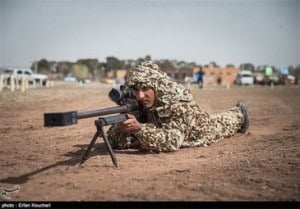A senior commander in Iran’s Army told reporters on Mar. 23 that Special Forces would be deployed as “advisors” to Syria and Iraq. This would mark the first time that Army forces – in this case, commandos and snipers of the Rapid Response Battalions – will have operated outside Iranian borders since the Iran-Iraq War of the 1980s.
The Islamic Revolutionary Guard Corps’ (IRGC) military presence in the country is well-documented, but the announcement denotes the first time Iran’s Army has formally contributed to military operations in Syria, which has been an IRGC-led campaign since Tehran first began sending significant resources to the country four years ago.
Iran’s decision to integrate Army special forces into major foreign operations underscore its commitment to hone its expeditionary capabilities. In fact, the Army’s involvement in Syria may have begun several months ago, as the head of its ground forces did not deny a report of an Army helicopter spotted flying from Iraq to Syria in December.

An Iranian Army rapid response sniper equipped with AM-50 Sayyad rifle, an Iranian copy of the Austrian Steyr HS .50, during an exercise in March 2016.
The Army was Iran’s primary military force prior to the 1979 revolution. The IRGC, on the other hand, was established after the revolution as a praetorian guard charged with protecting the revolution and balancing against a coup by the Army, which the clerics viewed with suspicion for its prior ties to the monarchy. The two institutions have been rivals ever since. The Army is a traditional military organization, while the Guard pursues asymmetric and “revolutionary” warfare. Each has its own ground, navy, and air branches.
Since 1979, however, the clerics have marginalized the Army in favor of the IRGC. The Guard receives better equipment and funding, even though it is only one-third in size (150,000 men compared to 350,000). It now dominates Iran’s military affairs, producing almost all of the senior officers in the General Staff. Still, the Army is not totally irrelevant.
The Army, for example, appears to be responsible for securing Iran’s western border with Iraq. The army’s ground forces commander announced in mid-March that his team and intelligence apparatus had neutralized two Islamic State infiltration cells and suicide vests at the border. The ground forces also reportedly deployed troops, helicopters, and drones to border crossings to provide security for 800,000 Iranian pilgrims to Iraq in December 2015.
The newly announced Army deployment to Syria and Iraq represents a departure from its constitutional mission to protect Iran’s territorial integrity. And while there have been no reported sightings – or casualties – of Army troops yet in Syria or Iraq, the deployment announcement came after the warring parties in Syria agreed to a cessation of hostilities last month.
February’s cessation of hostilities agreement means Iran no longer needs the 2,500 troops with which it launched last month’s offensive in northern Aleppo to cut off the main rebel supply route from Turkey. Iran has reportedly kept 700 military “advisers” in Syria. Announcements of IRGC fatalities in Syria have continued since the ceasefire announcement. Despite reports that Iran is drawing back its deployment in Syria, therefore, this week’s announcement is merely a reflection of Tehran reconfiguring its forces in the country to reflect changing conditions on the ground.
Long War Journal contributor Amir Toumaj is an Iran research analyst at the Foundation for Defense of Democracies.








6 Comments
Again, the Army has the better equipment utilizing the Best Tanks in the Iranian Arsenal and the best artillery. It is well trained and it coordinates with the IRGC.
IRGC utilizes updated T-55s and towed artillery.
Nor is IRGC a Praetorian Guard. Its not set up for it. If the Army revolted, the Mullahs are screwed. During the 2009 Protests neither IRGC or the Army deployed.
Special Units Command of NAJA is the Praetorian Guard and it is they who ensure the Mullahs are safe and they who cracked down on protestors in 2009.
Perhaps the IRGC wants the Artesh for what would amount to cannon fodder?
The most difficult part of this is the lack of American knowledge of who these combatants are. Some know, but they’re ridiculed by liberals and “New socialists” who believe we just need to offer them a good job. We can only hope that some of the people in charge are capable of remembering what happens when you appease an enemy your sure can beat the Snot from you. Wise up.
NOW SEND MORE SHOCK UNITS TO FIGHT ISIS IN SYRIA AND IRAQ. WHO IS THE NEXT MOVE? SEND THE ENTIRE IRANIAN ARMY TO TAKEOVER THE MID-EAST.
Talk about Iranian imperialism! The Left always bitches about US “imperialism” but I guess we won’t hear any complaints about what Iran is doing, namely forming satellite states in its periphery .
This is exactly what IS have wanted all along. Drawing Iran into full blown war.